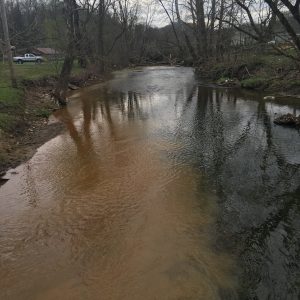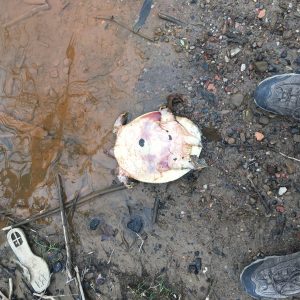Front Porch Blog
Another example of the costs that communities near coal mines pay in ecological, economic and human health.

With support from local residents, the Appalachian Water Watch is responding to coal pollution events like the recent spill along Pine Creek in Letcher County, Ky. Photos by Tarence Ray
A lot of folks have had questions about the recent mine blowout on Pine Creek, in Letcher County, Ky. So we’ve put together an explainer that runs through the facts, the science and the regulatory protocols behind spills like this.
Where is Pine Creek?
Pine Creek is a small creek that flows off Pine Mountain and into the North Fork of the Kentucky River. The point where Pine Creek and the Kentucky River meet is roughly five miles upstream of the municipal drinking water intake that serves Whitesburg, Ky., and the surrounding county.
So what happened?
On Friday, March 18, an auger mine company, Hardshell Tipples, was mining at the head of Pine Creek when they inadvertently drilled into an old underground mine. Water had stored up in the mine over time, slowly increasing in acidity and iron content creating what is called “acid mine drainage.” This water rushed out into a sediment pond when the mine was breached by the auger drill, and the pond overflowed into the creek.
What is acid mine drainage?
Acid mine drainage occurs when water flows over or leaches through minerals and materials with high sulfur content. Many times, as in the case at Pine Creek, the minerals exposed to water contain iron pyrite, also known as “fool’s gold.” The result is orange-colored water, which stains rocks and river beds. Acid mine drainage also very likely contains other metals, such as manganese. (The polluted water/mine drainage that spilled into Pine Creek contained manganese, and we’ll get to those test results momentarily). As is indicated by its name, acid mine drainage is also highly acidic — so don’t touch it.
But if all these things are found in nature, isn’t this simply a natural occurrence?
All of the ingredients for making acid mine drainage are naturally occurring, that much is correct. But what is not natural is the excavation of these minerals and their exposure to air and water. Ask yourself: is there anything natural about a stream that is unable to support wildlife?
In the case of Pine Creek, water had stored up in the old underground mine over time, slowly gaining acidity and various metals. These mountains are porous; therefore water got into the mine in the first place through years and years of rain. When the iron pyrite in the mine was exposed to oxygen in the water (you know, the “O” in H2O), it created a highly acidic substance that was harmful for aquatic life. When the mine was breached, this highly acidic substance got into the creek, and was indeed very harmful to aquatic life.
Got it. So back to what happened. What happened?
Our Appalachian Water Watch team was contacted by a concerned citizen who lives on Pine Creek, and we were able to document the spill as it occurred in real-time. Photos of dead fish and turtles were posted and shared by hundreds of people on Facebook and Twitter. We also spoke to residents on the creek who had been trying to catch minnows that morning. Instead, they had a net full of dead fish.
Officials at the Kentucky Department of Environmental Protection initially denied that the spill was responsible for killing wildlife. However, due to public pressure from social media and citizens filing complaints, state officials reversed their findings and determined that over 700 fish were killed as a result of the spill.
The state eventually issued four violations against Hardshell Tipples, and compelled the company to commit to a fish-restocking plan for Pine Creek — a huge victory for clean water advocates and a sign that the state is aware of the public’s concern about how state agencies respond to spills like this.
Was this preventable?
Samples taken on the day after the spill show massive amounts of iron and manganese in the water. State documents obtained by Appalachian Voices and the Appalachian Citizens’ Law Center show that Hardshell Tipples had been issued multiple violations in the past for discharging high amounts of iron from its permit. However, these violations were considerably lower than the most recent Pine Creek spill, and the pictures show it.
It’s established fact that Hardshell Tipples has been reckless in the past with what it choose to discharge off of the permit. But state documents reveal that the company was also issued a citation in 2002 for failing to submit comprehensive underground mine maps to the state. It might be impossible to determine whether this documented negligence had anything to do with the recent mine blowout; however, it’s safe to say that the company has been a consistently careless operator in a watershed that is both ecologically and aesthetically important to eastern Kentucky.
The mine blowout on Pine Creek was clearly preventable. However, this is not to imply that all incidents of acid mine drainage are preventable. The majority of acid mine drainage problems in Letcher County, for example, are from mining that occurred decades ago, and persist to this day. These legacy problems will likely exist for many more decades, unless action is taken by state and federal government agencies.
The main point is that the Pine Creek spill is yet another example of the costs that communities near coal mines have to pay for in terms of ecological, economic and human health.
What do I do if this happens to my creek?
In this case, the quick response of nearby citizens and our team pushed the state to action and prevented the mine waste from affecting Letcher County’s municipal water system. However, in other instances, communities may not be aware of the problem for days, or they may be unable to contact their proper state agencies — especially if the problem begins on a weekend.
In any case, there are several things you can do to get the state to respond:
1. Take photos. Put your photos on social media, and make sure you tag the respective state or federal agencies in your post. Pictures of dead wildlife are especially useful, as they paint a more comprehensive portrait of the affected stream.
You can also send the photos to us through the Appalachian Water Watch Facebook page. If you don’t use social media, make sure you hang on to the photos, and call us immediately at 1-855-7WATERS.
2. Take notes. Make sure you note the date, time, location and any other characteristics of the affected stream. This includes changes in water color, consistency and/or smell. Don’t touch the water unless you’re taking a sample, in which case you should wear gloves.
3. Take a sample. Contact us and we can likely sample the spill within a few hours. If nothing else, purchase a plastic water bottle from your nearby grocery, empty it out, fill it with the contaminated water, and store it on ice until it can be tested. Be sure to wear latex gloves when you grab a sample. The water is likely highly acidic, and could burn your skin. Also, be careful — don’t risk a broken ankle or worse by wading into a fast moving stream just to get a sample. Pictures and notes are often the best course of action.
PREVIOUS
NEXT

Leave a comment
Your email address will not be published. Required fields are marked *
4 responses to “What happened on Pine Creek?”
-
i know better because they have not not mine in pine creek and also would not come from pine mountain at all they do not mine there either and also that historical forest and national park you full of crap and also that red crap is not from the coal mines it in all ky river and water ways is not sulfer either and also it comes from up under the river beds and also does not kill fish also i know that they have palce stuff to try to clean the ky river in letcher county in cown and towards kings creek as well but the coal mines does not cause this it comes from waterfalls and natural springs as well
-
Thx for a great article. Glad to see they are taking action! Keep up the awesome work guys.
-
I appreciated Mr. Ray’s explanation of the Pine Creek blowout, as well as KenCooke’s comments on what can be done to remedy the problem. So many opportunities await for “putting the mountains back together over the next 50 years.”. Such projects would generate productive jobs and rebuild communities decimated by the decline of the coal industry. In addition, if the state commits itself to an economic development plan that includes energy efficiency and renewable energy programs, thousands of jobs are possible, according to a recent study by Synapses Energy Associates. This region needs a good manufacturing base for economic recovery, and not another federal prison which is scheduled for construction in Lecher County!
-
This is an outstanding response to an environmental incident, careful documentation, clear, well composed images, direct and accurate descriptions delivered in a timely manner to the right agencies. (With follow up “pressure” to make sure things happen.
Old mine openings that discharge acid mine drainage can be addressed with specific treatment systems (settling ponds with limestone drains (Rock Creek, McCreary County) What’s needed is an inventory of where these sites are and development of a formal watershed management plan to address them.
There are folks in Letcher, Perry and Pike county with the skill set to design and install treatment systems. Our mining engineers and their contractors spent the last 50 years tearing apart these Mountains, They can be re-assigned to start putting them back together over the next 50 years.
With AML, ARC, EPA and local match, funds would be available to work on this. To make the case for funding, we’ve got to have a clear plan with good science behind it, AND, this is important, local champions willing to shepherd the process. I think we have all the ingredients ready to go in Letcher County and the North Fork for cleaner water and healthier streams.


Leave a Comment